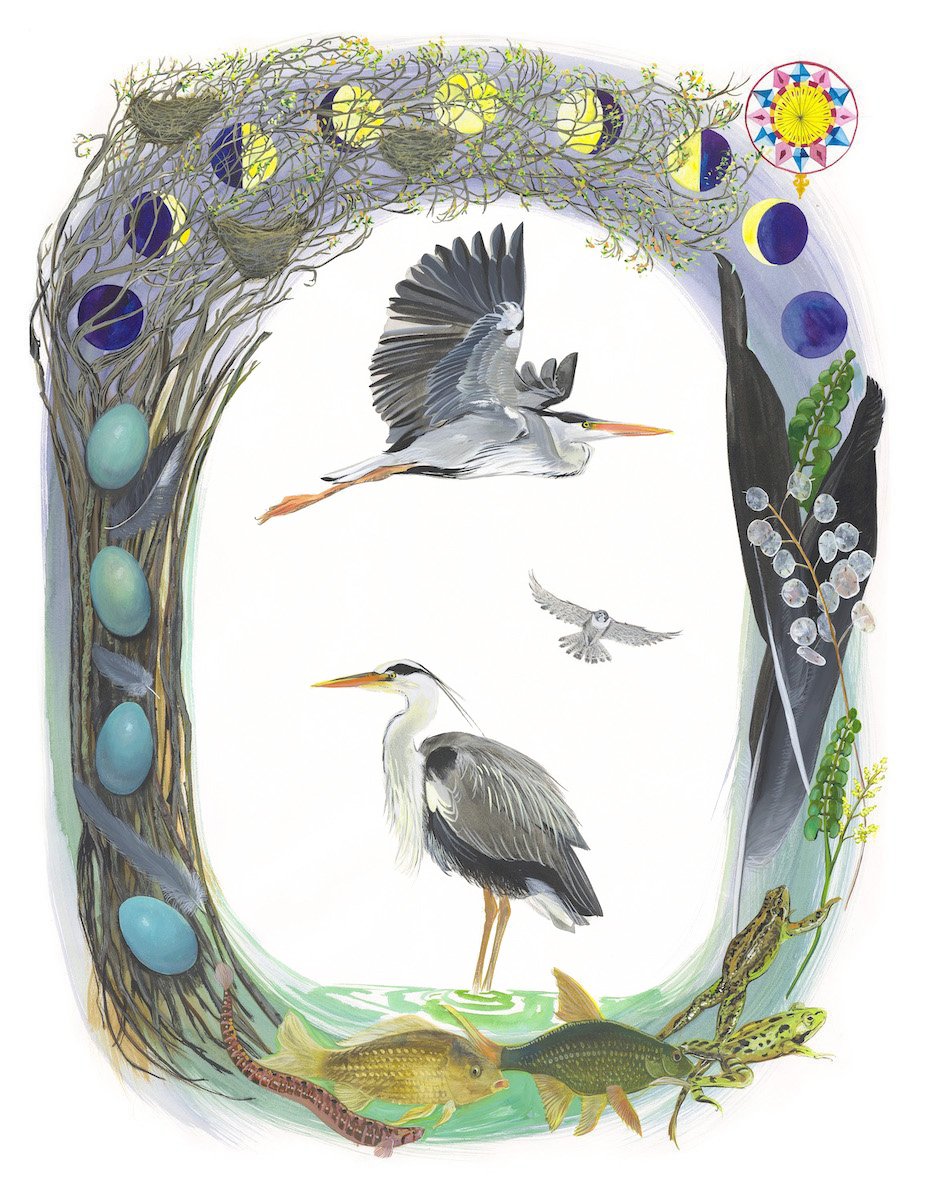Grey Heron (Ardea cinerea)
Painting by Missy Dunaway. Created with acrylic ink on paper. 30x22 inches (76x56 cm)
Painting Key
Fauna: 2 Grey herons (Ardea cinerea), 1 peregrine falcon (Falco peregririus), prey: 2 small carp, 2 common frogs, 1 rock gunnel
Flora: Lunaria leaves, lunaria seed pods, nesting material: sticks, dead reeds
Objects: 5 grey heron feathers, heronry comprised of three nests, phases of the moon, 1 compass rose from The Mariner’s Mirrour (1588)[1]
An illustration of a grey heron (top left) from 1676 by Francis Willoughby. Folger Shakespeare Library
Shakespeare’s Heron
Occurrences in text: 1
Plays: Hamlet
Name as it appears in the text: “Handsaw”
The tall, graceful Ardea heron walked the earth 7 million years ago and appeared in eighth-century written records.[2] The original text of Chaucer’s Prologe of the Frankeleyns Tale includes the word “heron” as we spell it today.[3] Shakespeare uses the term “handsaw,” and “hernshaw” was also used.
The grey heron is a skilled shoreline hunter who strikes its neck into water with lightning speed, then swallows large fish and amphibians whole. Despite their large size and carnivorous diet, herons are preyed upon by peregrine falcons and were a popular target in falconry.[4] The heron earned a reputation for cowardice because it is a passive bird that will not fight back and attempts to escape by flying as high as possible.[5] Hawks attack from above, so the two birds fight for the upper hand in the air, rising above each other in an impressive spectacle.[6]
Falcons attack two herons midair (top of page) in this illustration from “The booke of faulconrie or hauking” by George Turberville (1575).
Shakespeare never misses an opportunity to describe falconry, including his sole reference to the heron:
Hamlet (Act 2, Scene 2, Line 402)
HAMLET: I am but mad north-north-west: when the wind is southerly, I know a hawk from a handsaw.
In this line, Hamlet reveals that his madness is a controlled ruse: he acts mad in certain conditions, but he is sane enough to know the difference between two birds that are very different in appearance. It also references his power struggle with his uncle, Claudius. Despite acting naïve, Hamlet is aware of who is the predator and who is the prey. Hamlet could have made the same point with countless other prey birds. In 2 Henry VI, Lord Clifford uses doves to illustrate cowardice:
3 Henry VI (Act I, Scene 4, Line 40)
CLIFFORD: So cowards fight when they can fly no further;
So doves do peck the falcon’s piercing talons;
So desperate thieves, all hopeless of their lives,
Breathe out invectives ’gainst the officers.
As Lord Clifford describes, a dove fights back when it is a lost cause. It is a futile effort performed to save face—but it is still an effort. The heron’s total conflict avoidance is even more shameful given its large size. Hamlet chooses the heron because it represents a complete lack of courage and underlines his low opinion of his uncle.
Adding one more layer of complexity, Hamlet’s reference to a southern wind alludes to the heron’s migration patterns. The English ornithologist James Edmund Harting explains:
The heron, hern, or hernshaw signified the southerly wind, because it takes its flight from Ethiopia into Upper Egypt, following the course of the Nile as it retires within its banks, and living on the small worms hatched in the mud of the river. Hence the heads of these two birds may be seen surmounting the canopi used by the ancient Ægyptians to indicate the rising and falling of the Nile respectively.[7]
The association between herons and cowardice lost its significance when falconry fell out of popularity. However, Shakespeare’s audience would have felt the sting of this insult. For instance, The Vows of the Heron was a famous satirical Flemish poem from 1346 where Edward III is presented with three roasted herons at a banquet, implying his cowardice for not invading France. According to legend, this insult goaded the English king into invading France, thus beginning the Hundred Years’ War.[8]
My painting includes another piece of folklore from Shakespeare's time that The Bard does not mention. The heron was believed to gain weight by the waxing moon, oscillating from a plump form under a full moon to a slim frame under a crescent.[9] My painting includes sprigs of lunaria, also called money plant, moonwort, and honesty. This plant shares the heron’s association with the moon. Lunaria is Latin for “moon-shaped,” describing the plant’s silver, spherical seed pods. It was believed its leaves would number the days in a lunar phase.
Endnotes
[1] Ashley, A. Sir., Waghenaer, L., The Mariner’s Mirrour, 1588. (London: H. Hasselup. British Library Board, Creative Commons).
[2] Greenoak, F., All The Birds of the Air, 2nd ed, (Middlesex: Penguin Books Ltd., 1981), 37.
[3] “5.2 The Franklin’s Prologue and Tale.” Harvard’s Geoffrey Chaucer Website. Harvard University. https://chaucer.fas.harvard.edu/pages/franklins-prologue-and-tale. Accessed on April 4, 2022.
[4] Harting, J., The Birds of Shakespeare, (London: John Van Voorst, Paternoster Row, 1871)
[5] Harting, J., The Birds of Shakespeare, (London: John Van Voorst, Paternoster Row, 1871)
[6] Harting, J., The Birds of Shakespeare, (London: John Van Voorst, Paternoster Row, 1871)
[7] Harting, J., The Birds of Shakespeare, (London: John Van Voorst, Paternoster Row, 1871)
[8] Grigsby, John and Lacy, Norris. The Vows of the Heron (Les Voeux du Heron): A Middle French Vowing Poem (Library of Medieval Literature), (Garland, 1991).
[9] Greenoak, F., All The Birds of the Air, 2nd ed, (Middlesex: Penguin Books Ltd., 1981), 39.




